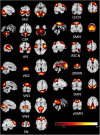The Effect of Long-Term Menstrual Pain on Large-Scale Brain Network in Primary Dysmenorrhea Patients
- PMID: 35923844
- PMCID: PMC9342881
- DOI: 10.2147/JPR.S366268
The Effect of Long-Term Menstrual Pain on Large-Scale Brain Network in Primary Dysmenorrhea Patients
Abstract
Purpose: Primary dysmenorrhea (PD) is a common gynecological disease, characterized by crampy and suprapubic pain occurring with menses. Growing evidences demonstrated that PD patients were associated with abnormalities in brain function and structure. However, little is known regarding whether the large-scale brain network changes in PD patients. The purpose of this study was to investigate the effect of long-term menstrual pain on large-scale brain network in PD patients using independent component analysis (ICA) method.
Methods: Twenty-eight PD patients (female, mean age, 24.25±1.00 years) and twenty-eight healthy controls (HCs) (mean age, 24.46±1.31 years), closely matched for age, sex, and education, underwent resting-state magnetic resonance imaging scans. ICA was applied to extract the resting-state networks (RSNs) in two groups. Then, two-sample t-tests were conducted to investigate different intranetwork FCs within RSNs and interactions among RSNs between two groups.
Results: Compared to the HC group, PD patients showed significant increased intra-network FCs within the auditory network (AN), sensorimotor network (SMN), right executive control network (RECN). However, PD patients showed significant decreased intra-network FCs within ventral default mode network (vDMN) and salience network (SN). Moreover, FNC analysis showed increased VN-AN and decreased VN-SMN functional connectivity between two groups.
Conclusion: Our study highlighted that PD patients had abnormal brain networks related to auditory, sensorimotor and higher cognitive network. Our results offer important insights into the altered large-scale brain network neural mechanisms of pain in PD patients.
Keywords: independent component analysis; primary dysmenorrhea; resting-state networks.
© 2022 Yi et al.
Conflict of interest statement
The authors in this work declare no conflict of interest.
Figures



Similar articles
-
Large-Scale Neuronal Network Dysfunction in Diabetic Retinopathy.Neural Plast. 2020 Jan 22;2020:6872508. doi: 10.1155/2020/6872508. eCollection 2020. Neural Plast. 2020. PMID: 32399026 Free PMC article.
-
Effect of Impaired Stereoscopic Vision on Large-Scale Resting-State Functional Network Connectivity in Comitant Exotropia Patients.Front Neurosci. 2022 Mar 8;16:833937. doi: 10.3389/fnins.2022.833937. eCollection 2022. Front Neurosci. 2022. PMID: 35350559 Free PMC article.
-
Abnormal Large-Scale Neuronal Network in High Myopia.Front Hum Neurosci. 2022 Apr 15;16:870350. doi: 10.3389/fnhum.2022.870350. eCollection 2022. Front Hum Neurosci. 2022. PMID: 35496062 Free PMC article.
-
Altered static and dynamic functional network connectivity in post-stroke cognitive impairment.Neurosci Lett. 2023 Mar 16;799:137097. doi: 10.1016/j.neulet.2023.137097. Epub 2023 Jan 27. Neurosci Lett. 2023. PMID: 36716911
-
Alterations of resting-state functional network connectivity in patients with noise-induced hearing loss: A study based on independent component analysis.Eur J Neurosci. 2024 Apr;59(8):2029-2045. doi: 10.1111/ejn.16266. Epub 2024 Jan 26. Eur J Neurosci. 2024. PMID: 38279577
Cited by
-
Abnormal Topological Organization of Human Brain Connectome in Primary Dysmenorrhea Patients Using Graph Theoretical Analysis.J Pain Res. 2024 Aug 27;17:2789-2799. doi: 10.2147/JPR.S470194. eCollection 2024. J Pain Res. 2024. PMID: 39220222 Free PMC article.
References
LinkOut - more resources
Full Text Sources
Miscellaneous

